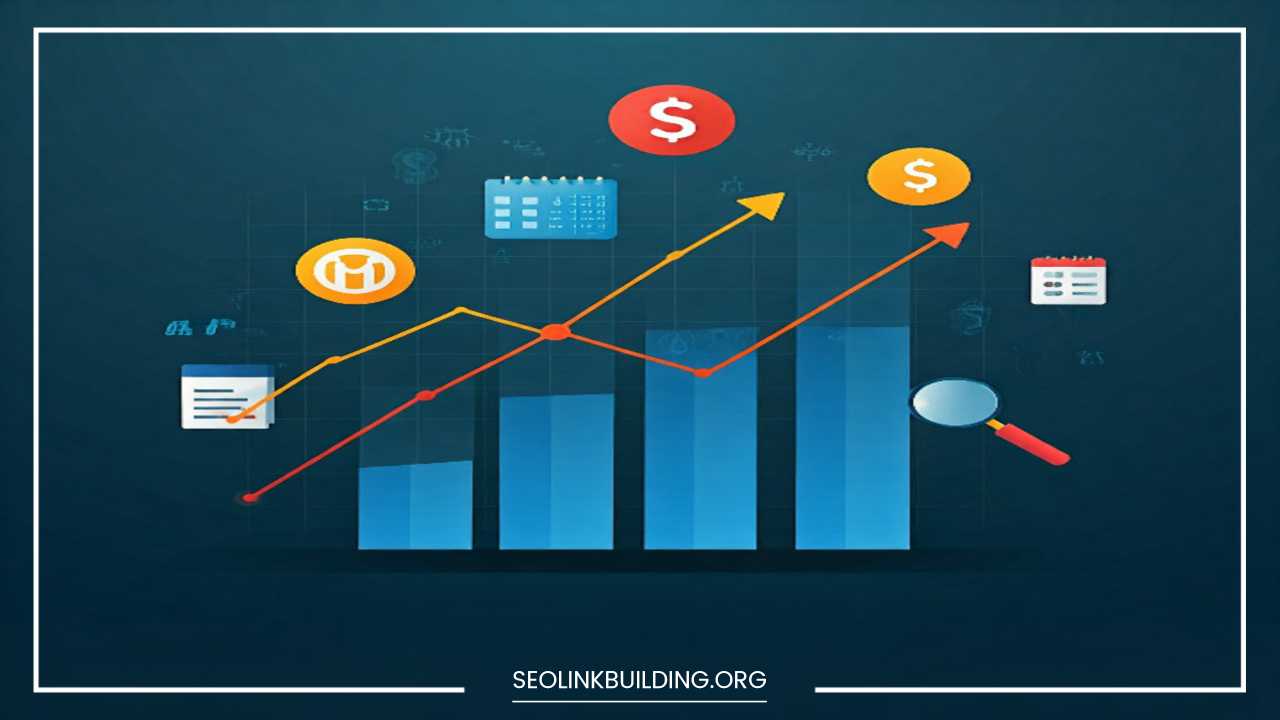SEO Forecasting: What is It & Why Does It Matter?

SEO Forecasting
SEO Forecasting: What Is It & Why Does It Matter?
Understanding the Future of Your Search Engine Optimization
In today’s digital marketing arena, where search engine algorithms are in constant flux and trends can shift overnight, predicting future SEO outcomes has become a critical component of strategic planning.
SEO forecasting involves the use of data, analytics, and predictive modeling to estimate how your website’s search engine rankings and organic traffic will develop over time.
This proactive approach not only aids businesses in making well-informed decisions but also in efficiently allocating resources and staying ahead of the competition.
What is SEO Forecasting?
SEO forecasting is a sophisticated method that leverages historical data, statistical analysis, and predictive modeling techniques to project future SEO performance.
This approach helps businesses anticipate changes in their search engine rankings and organic traffic, enabling them to adapt their strategies proactively. Here’s a closer look at the components involved in SEO forecasting:
- Data Collection and Analysis
- Keyword Rankings: Regularly tracking the positions of target keywords in search engine results pages (SERPs) provides insight into their performance over time. This data helps in understanding how well your website ranks for specific search queries and how changes in ranking positions impact organic traffic.
- Organic Traffic: Monitoring organic traffic involves analyzing the volume and quality of traffic coming to your website from search engines. This data reveals how effective your SEO efforts are in attracting visitors without relying on paid advertising.
- Backlinks: Backlinks are crucial for SEO success. Analyzing the quantity and quality of inbound links to your website helps in understanding the strength of your website’s authority and credibility, which are key factors in search engine rankings.
- Competitor Analysis: Evaluating your competitors’ SEO performance and strategies offers valuable insights into their strengths and weaknesses. This analysis can reveal opportunities for improvement and help you identify areas where you can outperform them.
- Search Engine Algorithm Updates: Search engines regularly update their algorithms to improve search results. Staying informed about these updates is essential, as they can significantly impact your website’s rankings and visibility.
- Building Predictive Models
- Statistical Analysis: Statistical techniques are used to identify patterns and trends in historical SEO data. Methods such as regression analysis and correlation analysis help in understanding how various factors influence SEO performance and in predicting future outcomes.
- Machine Learning: Machine learning algorithms can analyze vast amounts of historical data to recognize complex patterns and make accurate predictions. These models can learn from past data and continuously improve their forecasting accuracy as more data becomes available.
- Time Series Analysis: This technique involves examining data over different time periods to identify seasonal trends, cyclical patterns, and long-term changes. Time series analysis helps in understanding how SEO performance fluctuates over time and in forecasting future trends.
- Interpreting and Applying Insights
- Scenario Planning: Developing multiple scenarios based on different potential outcomes allows businesses to prepare for various possibilities. Scenario planning helps in understanding the impact of different factors on SEO performance and in developing strategies to address them.
- Risk Assessment: Identifying potential risks and challenges that could affect SEO performance enables businesses to create contingency plans. Risk assessment helps in mitigating potential issues and minimizing their impact on SEO efforts.
- Decision Making: Using insights from SEO forecasts to guide decision-making helps in optimizing SEO strategies. Data-driven decisions are more likely to yield positive results and improve overall SEO performance.
Why Does SEO Forecasting Matter?
SEO forecasting is crucial for several reasons:
- Proactive Decision Making
- Resource Allocation: Accurate forecasts allow businesses to allocate resources more effectively. By understanding where future SEO opportunities lie, businesses can focus their efforts and investments on areas with the highest potential return. For instance, if forecasting indicates that certain keywords are likely to become more competitive, you can invest in building a stronger backlink profile or improving content quality around those keywords.
- Risk Mitigation: Forecasting helps in identifying potential risks early on. For example, if an analysis reveals a possible decline in organic traffic due to an upcoming algorithm change, businesses can implement strategies to mitigate the impact, such as optimizing content or diversifying their traffic sources.
- Opportunity Seizing: Anticipating emerging trends and shifts in user behavior enables businesses to capitalize on new opportunities. For instance, if a forecast predicts an increase in search volume for specific topics, businesses can create targeted content to attract more visitors and improve their rankings.
- Improved ROI
- Optimized Campaigns: By forecasting the effectiveness of different SEO strategies, businesses can optimize their campaigns for maximum impact. This involves prioritizing strategies that are likely to yield the best results and adjusting or eliminating those with lower expected returns.
- Prioritized Efforts: Focusing on areas with the highest potential return allows businesses to drive significant improvements in organic traffic and conversions. For example, if forecasting indicates that a particular keyword or content type will likely generate substantial traffic, you can prioritize efforts to enhance that aspect of your SEO strategy.
- Enhanced Competitiveness
- Market Intelligence: Understanding competitors’ SEO strategies and performance helps in staying ahead of the curve. By analyzing their strengths and weaknesses, businesses can identify gaps and opportunities to outperform them.
- Strategic Advantage: Anticipating industry trends and changes positions your business for long-term success. For instance, if forecasts predict a shift in search behavior towards voice search, businesses can adapt their SEO strategies to include voice search optimization.
Key Components of SEO Forecasting
Effective SEO forecasting involves several key components:
- Data Collection and Analysis
- Keyword Rankings: Track keyword positions to assess how changes impact visibility and traffic. Regularly update your keyword list and monitor rankings to stay current with SEO trends and competition.
- Organic Traffic: Measure fluctuations in organic traffic to understand the effectiveness of your SEO efforts. Analyze traffic sources, user behavior, and conversion rates to gain insights into the performance of your SEO strategy.
- Backlinks: Assess the growth and quality of backlinks to strengthen your link profile. Evaluate the authority and relevance of linking sites and identify opportunities for acquiring high-quality backlinks.
- Competitor Analysis: Monitor competitors’ SEO performance and strategies to gain a competitive edge. Analyze their keyword rankings, backlink profiles, and content strategies to identify areas for improvement and differentiation.
- Search Engine Algorithm Updates: Stay informed about updates to search engine algorithms and adjust strategies accordingly. Subscribe to industry newsletters, attend webinars, and follow SEO experts to keep up with the latest developments.
- Predictive Modeling
- Statistical Analysis: Apply statistical techniques to interpret historical data and identify trends. Use regression analysis to understand how different factors affect SEO performance and to forecast future outcomes.
- Machine Learning: Utilize machine learning algorithms to analyze large datasets and make accurate predictions. Machine learning models can recognize complex patterns and improve forecasting accuracy over time.
- Time Series Analysis: Analyze data across different time periods to identify seasonal and long-term trends. Use time series methods to understand how SEO performance fluctuates and to make informed predictions about future trends.
- Interpretation and Application
- Scenario Planning: Develop and evaluate different scenarios based on potential outcomes. Scenario planning helps in preparing for various situations and in creating strategies to address potential challenges.
- Risk Assessment: Assess potential risks and develop strategies to mitigate them. Identify factors that could negatively impact SEO performance and create contingency plans to minimize their effects.
- Decision Making: Use insights from forecasts to guide decision-making and optimize SEO strategies. Data-driven decisions are more likely to lead to successful outcomes and improved SEO performance.
Best Practices for SEO Forecasting
To ensure effective SEO forecasting, follow these best practices:
- Set Clear Goals and Objectives
- Define specific goals and objectives for your SEO forecasting efforts. Align data collection and analysis with these goals to ensure that your forecasts are relevant and actionable. For example, if your goal is to increase organic traffic by 20% over the next six months, tailor your forecasting efforts to identify strategies that will help achieve this target.
- Choose the Right Tools and Techniques
- Select tools and techniques that match your needs and expertise. Consider using SEO analytics platforms, machine learning software, and statistical analysis tools to support your forecasting efforts. Ensure that the tools you choose provide accurate data and advanced forecasting capabilities.
- Continuously Monitor and Update
- Regularly review and update your forecasts based on new data and changing conditions. SEO is dynamic, and staying adaptable is crucial for maintaining accurate predictions. Update your forecasts to reflect changes in search engine algorithms, keyword trends, and competitive landscape.
- Collaborate with Experts
- Seek advice from SEO experts and data scientists who can provide valuable insights and enhance the accuracy of your forecasts. Experts can help interpret complex data, identify trends, and develop effective forecasting models.
- Stay Informed about Industry Trends
- Keep up-to-date with the latest trends, tools, and developments in the SEO industry. Staying informed will help you adapt to changes and incorporate new strategies into your forecasting models. Subscribe to industry blogs, attend conferences, and participate in professional networks to stay current.
Advanced Techniques in SEO Forecasting
For more advanced SEO forecasting, consider incorporating the following techniques:
- Predictive Analytics
- Use advanced predictive analytics techniques to forecast future SEO performance. Predictive analytics involves analyzing historical data to identify patterns and make predictions about future outcomes. Techniques such as regression analysis, clustering, and decision trees can provide deeper insights into SEO trends.
- Natural Language Processing (NLP)
- Leverage NLP techniques to analyze search trends and user behavior. NLP can help in understanding how users interact with search engines and how search queries are evolving. This insight can be used to optimize content and improve keyword targeting.
- A/B Testing
- Conduct A/B testing to evaluate the impact of different SEO strategies on performance. By testing variations of content, keywords, or link-building approaches, you can identify which strategies are most effective and incorporate these findings into your forecasts.
- Conversion Rate Optimization (CRO)
- Integrate conversion rate optimization techniques into your SEO forecasting efforts. Understanding how changes in SEO strategies impact conversion rates can help in predicting the overall ROI of your SEO campaigns.
- Competitor Benchmarking
- Perform in-depth competitor benchmarking to gain insights into their SEO strategies and performance. Compare your forecasts with those of competitors to identify opportunities for improvement and to ensure that your SEO efforts are competitive.
Final Thoughts
SEO forecasting is a powerful tool that can significantly enhance a business’s ability to make informed decisions, improve return on investment, and stay ahead of the competition.
By leveraging data, analytics, and predictive modeling, businesses can gain valuable insights into future SEO performance and proactively adapt their strategies.
Embracing a proactive approach to forecasting not only helps in navigating the complexities of digital marketing but also empowers businesses to leverage data-driven insights for sustained growth and competitive advantage.
Incorporating advanced techniques and best practices into your SEO forecasting efforts will further enhance your ability to predict future outcomes and optimize your SEO strategy.
By staying informed about industry trends, collaborating with experts, and continuously monitoring and updating your forecasts, you can ensure that your SEO efforts remain effective and aligned with your business goals.













